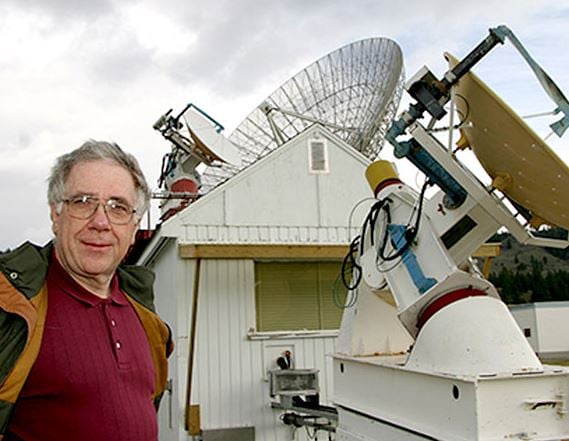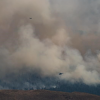You don’t have to worry about staying up late to catch this solar eclipse.
In fact, it might even be the best solution in decades to quashing your case of the Mondays.
On August 21st at 9:13 a.m. (PST), the most spectacular solar eclipse in North America since 1979 will follow a path from Oregon to South Carolina.
The last major eclipse to light up North American skies happened 38 years ago, in 1979. But according to Ken Tapping, the 2017 eclipse is 'tailor made for North American viewers.'
"All eclipses are special in their own way," said Tapping, astronomer at the White Lake Observatory in Penticton. "But this one is tailor made for people observing from North America. There is a tiny little patch of earth where if you stand there, the moon will completely cover the sun, and because the moon is moving across the face of the sun, that little spot on earth, which is about 100 kilometres across, will move across the country."
As an astronomer, Tapping has been waiting years for something this sensational to take to the skies and he's certainly not going to miss it. The good news is that residents in the Okanagan are going to have a view almost on par with Oregon's.
While the best viewing seats in the house are going to be in Oregon, it will proceed southeast across the whole of North America and you can bet you'll be able to see more than a glimpse of the action in the Okanagan, according to Tapping.

"For most of the Okanagan...we will see the sun start to be blocked out by the moon until eventually the moon covers 90% of the sun's diameter," said Tapping. "So the sun will never be completely covered, and then the moon will move on, and the sun will be revealed as it was before."
The eclipse will start around 9:13 a.m. and then at about 10:25 a.m. the moon will be at its fullest, with almost 90% of the diameter, and then the show is expected to end by 11:42 a.m.
Tapping bets B.C. will provide a decent viewing location and is certainly going to be less crowded.

"You'll be lucky to even find a space at the side of the road where you do the observing. I think every hotel is booked absolutely solid," he said, referring to Oregon.
British Columbians will get about 90% of the diameter, but the further east you go across Canada, the more that percent is going to drop.
Quebec and Nova Scotia should be able to view about 60% of the diameter and the Northwest Territories will see 30% of the show.

With B.C.'s wildfires burning in the background, many have wondered if the eclipse will be visible through the smoke.
Tapping said the smoke won't be an issue on its own, but it may cause viewers to misjudge how bright the solar eclipse actually shines.
If the smoke is thick, then the sun will look more like a "big, red bowl in the sky" and it may cause people to think they can stare at the eclipse longer than they should.
It's the infrared that damages the eyes, he said.
"The reason the sun appears red is the blue light and green light are scattered off in all directions, but the red light passes through and the infrared will be passing through the smoke," he said.
"Even if the sun looks safe to look at with the smoke, don't stare at it unless you have the right sort of eye protection."

He warns people off grabbing any old protective eye wear.
According to the Royal Astronomical Society of Canada, welder's glass with a number 14 filter shade is one of the most widely available filters safe for viewing the eclipse.
But by now, many of the proper eye wear options are sold out.
"There are a lot of sources on the web where they are not proper glasses at all and you can wind up blinding yourself."
There is however, another way.
"There is a technique called a pinhole technique that does work," said Tapping.

"You take a piece of cardboard, a couple feet square, make a hole a few centimeter's diameter in the middle and you put some cooking foil over that. Then you make a small pinhole in the cooking foil. The thing acts a pinhole camera," explained Tapping.
Another option is to project an image onto another piece of blank card. Read here for further instructions.
"With the proper eye protection in very short supply that might be the best way to approach it. There are clever tricks you can do with telescopes, but unless you know exactly what you're doing you could blind yourself."
During the 1979 eclipse, he was involved with a safety project at a children's hospital in Ontario. During that time, a doctor showed him images of the back of a child's eye who had looked at the sun through a telescope.
"The result was a permanent scar in the shape of a partially eclipsed sun on the back of his eyeball. His eyes went from 20/20 to 22/100 in the fraction of a second."

Tapping's eyes will be viewing the eclipse will be through a brand new telescope at the research station.
With a price tag of $2.5 million (including hours to assemble), Tapping said it's actually quite a small one and is cheap by astronomical instruments standards.
"We have a brand new radio telescope called a Next Generation Solar Flux Monitor. It's part of Canada's program of monitoring the sun and telling people what the sun is up to."
He said this is a prime time to gather tons of information about the sun.
"What is happening is the sun is the engine that drives space weather," he explained. "This blast of stuff from the sun causes power outages, magnetic storms, pipeline corrosion, damages satellites, messes up GPS, and so on."
As society becomes more dependent on technology, it means more disruptions are bound to occur.
"The last big solar event that effected Canada was in 1989 in March when a large solar flare led to Quebec being in the dark for several hours and a financial impact on Canada of about $2 billion dollars," said Tapping.

This blackout occurred before the internet. Now, the number of potential disruptions are far greater.
"Imagine you're in Paris, go to the ATM and the money won't come out because the link to Canada is broken. We are critically dependent on infrastructure now and need to understand the effects of space weather and the engines driving it much more precisely than we did. That really is the reason we built this new instrument."
Tapping predicts it will be several decades before anything like this event comes through this part of Canada.
"This is our opportunity, so we're doing our best to make sure this is going to work."
In 1975, tapping moved from England to Canada and joined the National Research Counsel and by 1990, he was in Penticton.
Remember if you're planning to view the solar eclipse on Monday, arrive at the correct time, take precautions by selecting appropriate eye wear, and relish the historical moment.
















